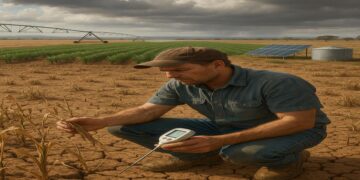How Climate Change Is Influencing Investment Decisions in Australia

The Evolving Investment Landscape in Australia
Australia is at a crossroads as the impacts of climate change have begun to significantly shape not only our environment but also the strategies employed by investors. With the climate crisis escalating, a newfound awareness regarding environmental factors has emerged, urging investors to reevaluate how they allocate their resources. This transformation is largely driven by a deeper understanding of the multitude of risks and opportunities associated with climate adaptability and sustainability.
The Australian investment landscape is undergoing a profound transformation, characterized by priorities that reflect the pressing realities of climate change. Among the most influential factors shaping these pivotal decisions are:
- Regulatory Changes: The Australian government has introduced several policies aimed at reducing carbon emissions and promoting renewable energy. For instance, the Emissions Reduction Fund provides financial incentives for projects that lower greenhouse gas emissions, making it an attractive avenue for investors seeking to align with government objectives.
- Market Demand: As consumers increasingly gravitate towards eco-friendly products, businesses are responding by investing in sustainable practices. Companies like Officeworks, for instance, have shifted towards providing recycled materials and sustainable office supplies, demonstrating a strong business case for green investment.
- Risk Assessment: The rising frequency of natural disasters—such as bushfires, floods, and droughts—has changed the risk profiles associated with various sectors. Insurers are recalibrating their risk models, which impacts investment strategies significantly. For example, property investments in bushfire-prone areas have become more scrutinized as the potential for loss increases.
On a global scale, the trend toward sustainability is unmistakably influencing Australia’s financial sector. Investment firms are increasingly prioritizing projects that promise both resilience and longevity. Renewable energy initiatives such as wind farms and solar power installations are not just viewed as ethical choices; they are becoming lucrative investments. Companies like Fortescue Metals Group are now actively investing in green hydrogen projects, paving the way for a sustainable energy future.
As we grapple with these pressing circumstances, understanding the intricate relationship between climate change and investment strategies is paramount. The choices made in today’s financial environment will undoubtedly shape Australia’s economic landscape for generations to come. They reflect a growing commitment from investors to embrace sustainable practices that not only nurture the planet but also promise long-term profitability.
In summary, the intersection of climate change and investment strategies is no longer a niche topic but has become a central theme in shaping Australia’s economic trajectory. The evolving landscape presents an opportunity for investors to engage in practices that are not only beneficial for the environment but also create lasting economic value.
Shifting Perspectives: The Investor’s Outlook
As climate change continues to assert its dominance across various sectors, Australian investors are facing a transformative moment that requires them to rethink traditional investment paradigms. The escalating impact of environmental changes is prompting a surge in interest towards sustainable investments, reflecting not only a moral responsibility but an economic opportunity. Recognising climate change as a significant factor in investment decisions is reshaping capital flows and altering the risk-return profile of many asset classes.
Investors are increasingly arming themselves with insights drawn from climate-related data to inform their choices. This shift is evident in the growing popularity of Environmental, Social, and Governance (ESG) investing. ESG criteria allow investors to gauge a company’s long-term viability while assessing its environmental impact and corporate governance structures. In Australia, major superannuation funds, such as AustralianSuper and UniSuper, have begun committing a greater portion of their portfolios to ESG-compliant assets. This move demonstrates an alignment with consumer values and an acknowledgment that sustainable investments can yield higher returns in the long run.
The factors influencing these investment decisions are diverse, but a few key trends stand out:
- Increased Stakeholder Activism: Investors are advocating for corporate accountability, pressing businesses to disclose their climate risks transparently. This can lead to companies realigning their strategies towards sustainability, which in turn enhances their appeal to socially conscious investors.
- Technological Innovation: The acceleration of clean technologies is creating new investment avenues. Australian startups are emerging in renewable energy, electric vehicles, and energy efficiency solutions, attracting significant venture capital funding as innovators lead the charge toward a sustainable economy.
- Capital Flow Dynamics: Traditional industries, such as fossil fuels, are experiencing a capital exodus as investors anticipate the long-term decline of these sectors in favour of green alternatives. This can significantly influence market valuations and necessitate a reevaluation of risk among investors.
Moreover, the global narrative surrounding net-zero commitments is empowering Australian investors to restructure their portfolios with a future-focused lens. Major corporations are vying to meet or exceed governmental targets, often incorporating renewable technologies into their operational frameworks. This drive towards lower emissions is fostering increased interest in investments that promise to contribute to a sustainable economy. One exemplary illustration is the rise of battery storage technologies in response to Australia’s abundant solar energy potential, which is becoming an attractive sector for both institutional and retail investors alike.
In summary, the evolving perspective on investment in the context of climate change is a reflection of broader societal shifts. Investors are increasingly aware that addressing climate risks is not merely an ethical obligation but a critical strategy for capital preservation and growth. As the Australian investment landscape continues to adapt, those who embrace sustainability stand to benefit not just economically, but also in fostering a resilient future for the country and its natural surroundings.
Emerging Opportunities: The Green Investment Landscape
As climate change continues to exert pressure on natural resources and social frameworks, the green investment landscape in Australia is transforming into a vibrant arena packed with potential. This shift is not merely an adaptation; it presents a wealth of opportunities for investors embracing a sustainable future. Particularly noteworthy is the Australian government’s commitment to achieving net-zero emissions by 2050, which is catalyzing significant policy reforms and incentivising investments in clean technologies.
One sector that is gaining remarkable traction is renewable energy, with wind and solar becoming frontrunners in Australia’s energy mix. The government’s investments in large-scale renewable projects are fostering a competitive environment, encouraging both local and international investments. Australia boasts some of the world’s highest solar irradiation, making it an ideal candidate for solar power production. For instance, the BHP’s investment in solar farms exemplifies a paradigm shift as traditional industry giants pivot towards environmentally friendly energy sources.
Furthermore, advancements in green finance mechanisms such as green bonds are capturing investor interest. Australian entities are rapidly issuing green bonds to fund environmentally responsible projects, which translate into an array of investment opportunities. According to the Climate Bonds Initiative, the Australian green bond market is expected to grow significantly, driven by institutional investors eager to allocate their capital towards climate-resilient initiatives that yield environmental benefits as well as financial returns.
Climate risk assessments are also becoming increasingly sophisticated, compelling investors to include climate scenarios in their financial models. This institutional accountability is leading to a more environmentally conscious investment culture that creates resilience in the face of climate change. Research by the Australian Securities and Investments Commission emphasises the necessity for companies to disclose material climate risks, encouraging a more transparent investment landscape. As investors scrutinize climate-related disclosures, those companies that fail to report transparently may face a risk of capital flight.
The adoption of sustainable agriculture practices offers an intriguing opportunity for investors as well. As droughts and shifting weather patterns impact traditional farming techniques, innovative solutions such as regenerative agriculture and organic farming are emerging. These not only mitigate environmental impacts but also create a niche market that appeals to health-conscious consumers and investors alike. Companies like Goodwhale, which focuses on promoting sustainable seafood, represent a shift in investor sentiment towards ethical consumption.
In tandem with these developments, the role of impact investing is gaining importance in the Australian context. Impact investors contribute capital to social and environmental projects while seeking measurable positive outcomes. As an example, initiatives funding renewable energy projects in remote Indigenous communities produce both financial returns and social benefits, ensuring access to sustainable energy while supporting local cultures and economies.
The ripple effects of climate change on investment decisions are still unfolding in Australia as investors increasingly regard sustainability as a core component of their strategy, not merely a trend. As the market landscape evolves, shifting priorities open new pathways for innovation and collaboration among investors, corporate entities, and government bodies, propelling Australia towards a more sustainable economic future. The focus on both mitigating climate risk and capitalizing on emerging opportunities will ultimately prove crucial for shaping investment strategies in the years to come.
Conclusion
The evolving narrative surrounding climate change in Australia is dramatically reshaping investment decisions across multiple sectors. As this environmental challenge presents both risks and opportunities, the shift towards a sustainable investment culture is becoming imperative. Investors are now prioritizing climate resilience in their portfolios, recognizing that sustainable practices are no longer merely ethical choices, but strategic imperatives that can yield significant returns.
Renewable energy, green finance, and sustainable agriculture stand out as key areas reflecting this shift. The Australian commitment to reaching net-zero emissions by 2050 acts as a strong motivator, galvanizing private investments into substantial environmental projects. Through the growth of green bonds and the refinement of climate risk assessments, investors are increasingly equipped to make informed decisions that align with both their financial goals and the planet’s well-being.
Moreover, impact investing serves as a bridge between profitability and positive societal outcomes, offering pathways for investors to engage with local communities, especially in remote areas that face the brunt of climate effects. As Australia navigates this transition, the collaboration between government, businesses, and investors will be vital in unlocking new realms of innovation and sustainability.
In conclusion, the influence of climate change on investment decisions marks the dawn of a new era in Australia, where sustainability is not just a trend but a foundational element of economic strategy. Investors who embrace this paradigm will not only secure their interests but will also contribute to a more resilient and sustainable future for all Australians. The journey ahead is filled with challenges, yet the prospects for growth in a green investment landscape are abundant and compelling.

James Carter is a financial writer and advisor with expertise in economics, personal finance, and investment strategies. With years of experience helping individuals and businesses make complex financial decisions, James offers practical insight and analysis. His goal is to give readers the knowledge they need to achieve financial success.






